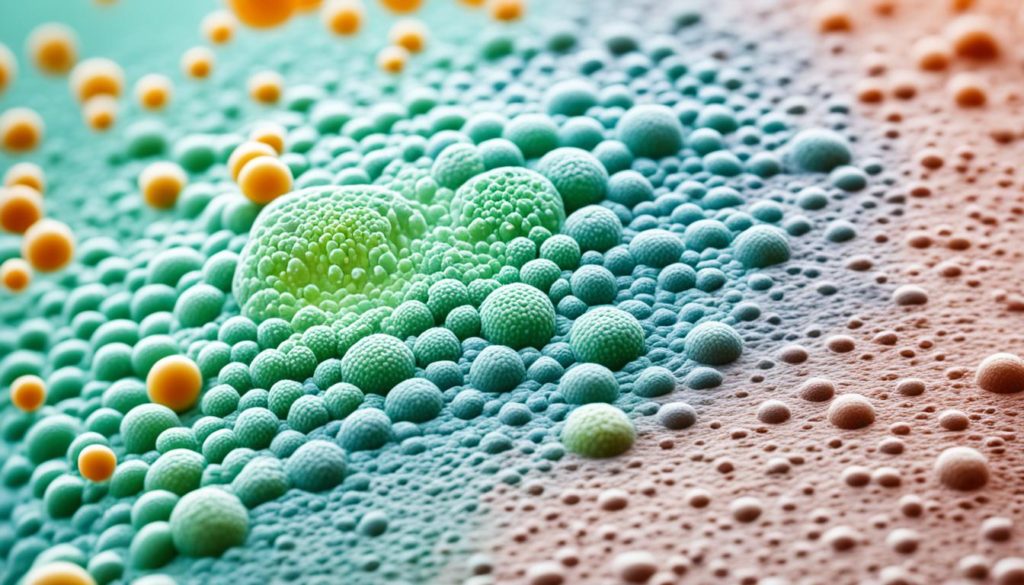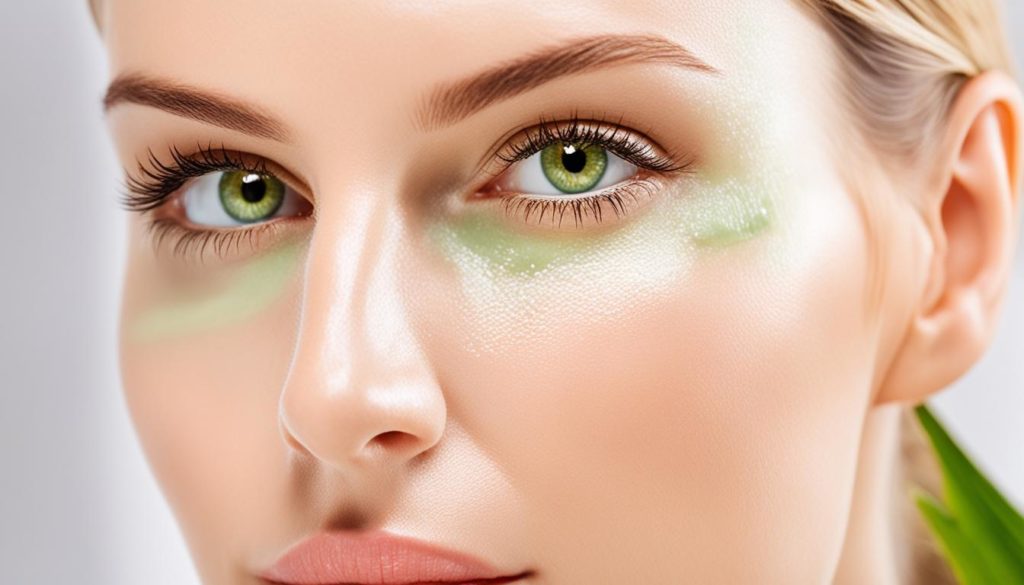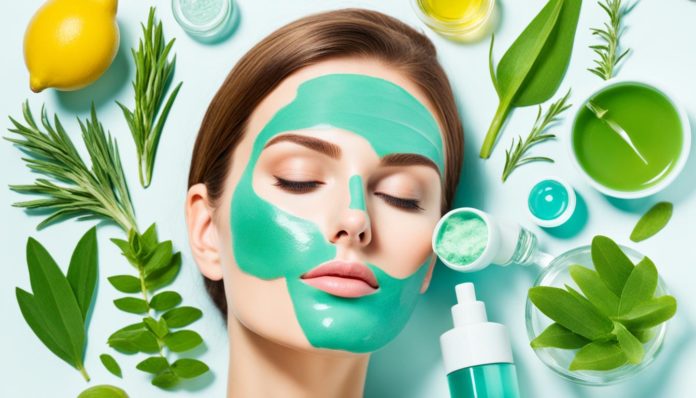Did you know nearly 50 million Americans battle acne every year? It’s the top skin issue in the U.S. This huge number shows we need good ways to fight acne. Acne can hurt how you view yourself and affect your happiness.
We’ve put together a guide to show you how to beat acne. We’ll cover everything from what causes acne to the best treatments out there. Our article will give you the tools to get clear, glowing skin.
Key Takeaways:
- Acne affects nearly 50 million Americans each year.
- This guide provides proven banisch acne solutions and clear skin tips.
- Understanding the root causes of acne is essential for effective treatment.
- Discover various acne treatment methods recommended by dermatologists.
- Learn how to maintain clear, healthy skin through a dedicated skincare regimen.
Understanding Acne: Causes and Triggers
Acne is a complicated skin condition caused by many things. We’ll look at the main causes and what makes it worse. These insights are vital for anyone struggling with acne.

Hormonal Factors
Hormones play a big role in acne, especially for teens and women. Teens see more acne because of hormone surges during puberty. These surges make oil glands work overtime, leading to clogged pores. Women may also have acne tied to their periods, pregnancy, or menopause.
Knowing how hormones affect acne can guide us to better treatments. This is especially true for acne linked to hormonal changes.
Diet and Lifestyle
What you eat and how you live can also cause acne. Foods high in sugars and dairy products may lead to breakouts. Stress, not enough sleep, and poor skincare habits can make acne worse, too. Managing these aspects of your life can help control acne related to diet and lifestyle.
Genetic Predisposition
Acne can also run in families. If your parents had it, you’re more likely to get it, too. This genetic aspect affects how your skin reacts to different triggers, like hormone shifts. Knowing if acne is in your family can help you find the right skincare routine.
Effective Banisch Acne Treatments
Banisch offers many good treatments for acne. We look at both topical and oral options here. They have been proven to clear acne effectively.
Topical Treatments
Topical treatments are key in fighting acne on the skin’s surface. Topical retinoids are a top choice, reducing inflammation and stopping pores from clogging. Benzoyl peroxide and salicylic acid are also great. They kill bacteria and remove dead skin.

Studies show these treatments really help when used right. Dermatologists like them because they reduce breakouts and make skin smoother.
| Topical Treatment | Primary Ingredient | Effects |
|---|---|---|
| Retinoid Cream | Topical Retinoids | Reduces inflammation, prevents pore clogging |
| Benzoyl Peroxide | Benzoyl Peroxide | Kills bacteria, reduces sebum production |
| Salicylic Acid | Salicylic Acid | Exfoliates dead skin cells, unclogs pores |
Oral Medications
Banisch has oral meds for tough acne cases. Oral antibiotics for acne fight bacteria and swelling. Isotretinoin is great for severe acne, lowering oil and renewing skin.
Clinical trials back these oral treatments. They work well for hard-to-treat acne. Always talk to a dermatologist to pick the best oral medicine for you.
| Oral Medication | Primary Ingredient | Effects |
|---|---|---|
| Antibiotics | Oral Antibiotics for Acne | Reduces bacterial growth, inflammation |
| Isotretinoin | Isotretinoin | Decreases oil production, promotes skin renewal |
Banisch Acne: Product Reviews
Banisch acne products are making waves in the skincare world thanks to their unique formula and high success rate. People have been talking a lot about their experiences, pointing out what’s good and what could be better. This review will take a closer look at how effective Banisch products really are.
Banisch acne products are known for their cutting-edge ingredients. Take the Retinoid Serum, for example. It has shown impressive results in tests. Users are seeing fewer acne spots. Many say their skin is smoother and clearer in just a few weeks.
| Product | Benefits | Drawbacks | User Ratings |
|---|---|---|---|
| Banisch Retinoid Serum | Reduces acne lesions, smooths skin | Possible initial irritation | 4.5/5 |
| Banisch Exfoliating Cleanser | Unclogs pores, gentle on sensitive skin | May dry out skin if overused | 4.2/5 |
| Banisch Daily Moisturizer | Hydrates without greasiness, non-comedogenic | Higher price point | 4.8/5 |
People also enjoy how easy Banisch acne products are to use. Many acne treatment reviews say these products fit well into their daily skincare routines. With regular use, users notice better skin texture and clarity.
In the end, both user feedback and science show Banisch products work well. Following the product guidelines carefully, users see big positive changes. This makes Banisch a top pick for fighting acne.
Daily Skincare Regimen for Acne-Prone Skin
Managing acne-prone skin needs a focused plan. It’s about using the right products and routines. By following a gentle skincare routine, you can work towards clearer skin. This includes using soft cleansers, moisturizers that don’t block pores, and protecting skin from the sun.
Cleansing Routine
Start with gentle cleansers for acne-prone skin. Avoid harsh soaps and scrubs, as they can make breakouts worse by harming your skin’s barrier. Look for products marked as gentle or made just for acne.
Cleanse your face twice daily. Do it once in the morning and once at night. This removes dirt, oil, and pollutants that can cause acne.
Moisturizing Tips
Moisturizing is vital for acne-prone skin, even if it seems odd. Keeping your skin hydrated helps it stay healthy and can stop it from making too much oil. This can help prevent new breakouts. Choose moisturizers labeled non-comedogenic.
Look for ingredients like hyaluronic acid and glycerin. These help keep your skin moist without making acne worse.
Sun Protection
Using sunscreen is key for acne-prone skin. Some treatments for acne can make your skin more sensitive to the sun. Choose a broad-spectrum sunscreen with SPF 30 or higher that won’t clog pores. Sunscreen protects against harmful UV rays and prevents dark spots after acne heals.
| Step | Product Type | Recommended Ingredients |
|---|---|---|
| Cleansing | Gentle Cleanser | Salicylic Acid, Benzoyl Peroxide |
| Moisturizing | Non-Comedogenic Moisturizer | Hyaluronic Acid, Glycerin |
| Sun Protection | SPF for Acne-Prone Skin | Broad-Spectrum SPF 30+, Zinc Oxide |
Natural Remedies for Acne
Exploring natural acne treatments opens us to new and useful alternatives. These remedies use ingredients that are kind to your skin. They help reduce swelling and stop acne-causing bacteria.
Tea tree oil stands out for fighting acne. It kills bacteria and can lessen acne spots. Studies show it helps clear the skin.
Green tea extract is another great choice. It’s full of antioxidants and fights swelling. Using it can cut down on oil production that causes acne.
Manuka honey is known for its healing touch. It fights bacteria and swelling, making it great for acne care. A honey mask can calm your skin and speed up healing.
If you’re looking for organic acne solutions, consider natural astringents like apple cider vinegar. It helps keep your skin’s pH level balanced and fights bacteria. But be careful, as it’s very acidic.
Here’s a quick overview of these remedies:
| Remedy | Benefits | Risks |
|---|---|---|
| Tea Tree Oil | Reduces lesions, Prevents breakouts | Possible irritation, Allergic reactions |
| Green Tea Extract | Antioxidant-rich, Reduces sebum | Minimal risks, Skin dryness |
| Honey | Heals, Soothes inflammation | Potential allergies |
| Apple Cider Vinegar | Balances pH, Antibacterial | Skin irritation, Over-dryness |
When adding home remedies for acne to your care routine, know their pros and cons. Always talk to a dermatologist to get advice tailored to your skin. This ensures these natural treatments work well for you.
Banisch Acne Before and After: Real Results
Exploring the transformational power of Banisch acne treatments gives us a look at how advanced skincare can change lives. We see the incredible results of Banisch acne treatments through stories and case studies. Many have found newfound confidence thanks to these results.
Case Studies
Case studies in clinical settings show how well Banisch acne treatments work. One case involved a patient with severe cystic acne. Within six weeks, there was a big decrease in inflammation and scarring. Looking at these before and after pictures proves the product’s effectiveness. It also gives hope to those looking for real results.
Success Stories
Many share their success stories of achieving clear skin with Banisch. For example, a young woman with long-term acne saw major improvements. She had clearer, smoother skin after using Banisch products for a few months. These stories give hope to others fighting acne.
These success stories highlight the product’s effectiveness and its impact on lives. It’s the real experiences that show how a good acne treatment plan can make a difference.
Banisch Acne Tips for Sensitive Skin
Dealing with acne on sensitive skin can be tough. Yet, it’s possible to manage acne without extra irritation. Here’s what you should remember:
- Select hypoallergenic acne treatments. These products aim to lower the chance of allergic reactions. Look for “hypoallergenic” on labels to find what’s best for sensitive skin.
- Opt for gentle acne solutions. Skip strong chemicals like benzoyl peroxide and alcohol, as they can remove natural oils and increase sensitivity. Choose items with aloe vera and chamomile instead.
- Incorporate a consistent sensitive skin acne care routine. A routine focusing on gentle cleaning, hydration, and proper treatment helps manage acne while keeping skin healthy.
Let’s look at some suggested products:
| Product | Benefit | Key Ingredient |
|---|---|---|
| La Roche-Posay Toleriane Purifying Foaming Cleanser | Removes impurities without stripping the skin | Ceramide-3 |
| Cetaphil Gentle Skin Cleanser | Clinically proven to be gentle for sensitive skin | Glycerin |
| CeraVe Acne Foaming Cream Cleanser | Combines acne treatment with moisture-locking ingredients | Salicylic Acid & Niacinamide |
When caring for acne with sensitive skin, it’s crucial to be patient. Skin needs time to adjust to new products and care routines. A dermatologist can offer tailored advice. They can ensure you’re on your way to clear and healthy skin.
Combining Treatments for Best Results
Getting clear skin usually means using more than one treatment method. By mixing daily skincare with expert advice, you get better outcomes. This part will look at how a step-by-step acne plan and professional care can together clear acne.
Multi-Step Approach
A typical acne plan has steps like cleaning, peeling, treating, and moisturizing. Each step is key in fighting acne. For example, a soft cleanser takes away dirt. A special treatment, like benzoyl peroxide or salicylic acid, lowers swelling and stops new pimples. Moisturizing keeps the skin’s surface healthy, avoiding dryness and irritation that could make acne worse. Using these steps every day is the start to clearer skin.
Integrating Professional Treatments
Home care is important, but expert treatments can speed up the improvement. Options such as chemical peels, laser work, and microdermabrasion go deeper to tackle tough acne. Chemical peels take off dead skin, help new cells grow and open pores. Laser methods lessen redness and kill germs for a lasting effect.
Mixing expert care with a regular acne plan at home covers all bases. Regular visits to a skin doctor help customize care to your skin’s unique needs, making sure you get the best mix of treatments. In short, using both home and expert methods is often the top way to get clear, glowing skin.
FAQ
What is the Banisch acne treatment?
The Banisch acne treatment offers a full skincare plan. It uses science-backed ingredients and methods to lessen acne.
How does the Banisch acne treatment work?
Banisch uses a mix of retinoids, benzoyl peroxide, salicylic acid, and oral drugs. They fight oil, bacteria, and blocked pores.
Are Banisch acne products suitable for sensitive skin?
Yes, Banisch has acne products made for sensitive skin. They use mild yet effective ingredients, perfect for those with fragile skin.
What are the benefits of using Banisch acne products over other brands?
Banisch products are unique because of their proven formulas and dermatologist support. They target acne carefully while protecting your skin’s health.
How do I start a daily acne regimen with Banisch products?
Begin with a soft cleansing routine, then apply non-comedogenic moisturizers and needed treatments. Always finish with sunscreen to protect your skin.
Are there any natural remedies recommended by Banisch for treating acne?
Banisch suggests some natural remedies like tea tree oil and green tea extract. These work well with a complete skincare routine for acne.
Can I see before and after results of individuals using Banisch acne products?
Yes, Banisch shares before and after photos that show how people’s skin changed. This gives you a glimpse of what to expect.
What should I do if my acne does not improve with Banisch treatments?
If there’s no improvement, see a dermatologist. They can recommend other treatments to better suit your skin and acne type.
Are Banisch acne products reviewed positively by users?
Banisch products often get good reviews. Users praise their effectiveness and the noticeable improvement in their skin after regular use.
Is it safe to combine Banisch acne products with other acne treatments?
Combining Banisch products with others may work, but check with a dermatologist first. This helps avoid harmful reactions and ensures effectiveness.


